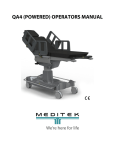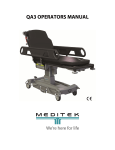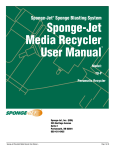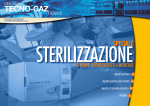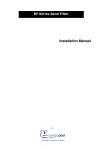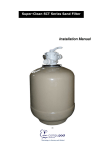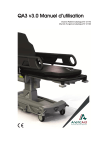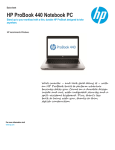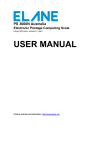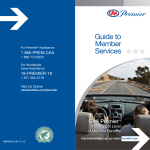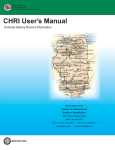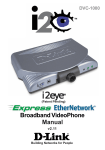Download QA4 (MANUAL) OPERATORS MANUAL
Transcript
QA4 (MANUAL) OPERATORS MANUAL QA4 Powered Operators Manual Contents 1. Introduction . . . . . 1.1. Warnings and Cautions . . . 1.2. Scope of Use . . . . 1.3. Equipment Classification . . . 2. Product Specifications . . . . 3. Product Functions . . . . . 3.1. Height Adjustment . . . 3.1.1. Problems Raising the Patient Platform 3.1.2. Pump Bleeding Instructions . . 3.2. Using the Brakes . . . . 3.3. Using the Steering Pedal . . . 3.4. Using the Backrest Function . . 3.5. Using the Trendelenburg Function . . 3.6. Using the Head Section . . . 3.7. Using the Leg Section . . . 3.7.1. Removing the Leg Section . . 3.7.2. Replacing the Leg Section . . 3.7.3. Articulating Leg Section (optional) . 3.8. Using the Stretcher Sides . . . 3.8.1. Rotating the Stretcher Sides . . 3.8.2. Removing the Stretcher Sides . 3.8.3. Replacing the Stretcher Sides . 3.8.4. Attaching the Full Length Stretcher Side 3.8.5. Rotating the Full Length Stretcher Side 3.9. Using the I.V. Pole . . . . 3.10. C-Arm Access . . . . 4. Patient Weight Limits . . . . 5. K8 Pressure Care Mattress . . . . 5.1. Infection Control . . . . 6. Cleaning and Disinfecting the Stretcher . . 6.1. Cleaning . . . . . 6.2. Disinfecting . . . . 7. Product Maintenance . . . . 8. Identifying Product Labels and Symbols . . 8.1. Common Symbols . . . 8.2. Steer Label . . . . 8.3. Brake Label . . . . 8.4. Leg Section Label . . . . 8.5. Head Section Label . . . 8.6. Articulating Leg Section Label . . 8.7. Raise and Lower Label . . . Page . . . . . . . . . . . . . . . . . . . . . . . . . . . . . . . . . . . . . . . . . . . . . . . . . . . . . . . . . . . . . . . . . . . . . . . . . . . . . . . . . . . . . . . . . . . . . . . . . . . . . . . . . . . . . . . . . . . . . . . . . . . 1 1 1 1 2 3 4 4 4 4 5 5 5 6 7 7 7 8 8 9 9 10 10 10 11 11 12 12 12 13 13 13 13 14 14 14 14 14 14 14 14 © Portsmouth Surgical Equipment Ltd and Anetic Aid Ltd. All rights reserved; this document is not to be reproduced in whole or in part without the permission of the copyright owners. The company reserves the right to modify or improve the equipment referred to. QA4 Powered Operators Manual 1. Introduction These instructions are intended to assist you with the operation of the QA4 Day Surgery Stretcher. It is important that these instructions are read thoroughly before using the equipment. It is also important to check the stretcher before use; ensure that all stretcher functions operate to their full range of movement and that all detachable components disengage, re-engage and lock correctly. We recommend that the stretcher is visually inspected for any loose or damaged parts, foreign objects caught in the castors, and hydraulic fluid leakage. 1.1. Warnings and Cautions Various warnings and cautions are made throughout these operating instructions. A WARNING is given when the personal safety of the patient or user may be affected and when disregarding this information could result in injury. A CAUTION is given when special instructions must be followed. Disregarding this information could result in permanent damage being caused to the stretcher. 1.2. Scope of Use This product is intended for use within a day surgery environment for the induction, transport, treatment and recovery of patients. While the stretcher can be used to transfer patients out of a surgical environment, the stretcher has not been designed as a patient transfer stretcher, as it has very low ground clearance that may cause problems when traversing uneven ground. CAUTION: The stretcher may be damaged by pushing it across rough or uneven ground. 1.3. Equipment Classification The stretcher has been classified as a ‘Class 1' device. © Portsmouth Surgical Equipment Ltd. Document No. 992008. Issue 11 – 19.07.11 Page 1 QA4 Powered Operators Manual 2. Product Specifications Fig. 1 Key to Fig. 1 Height (MIN) A. Height (MAX) B. Mattress Length C. Stretcher Length D. Mattress Width E. Stretcher Width (With Side Rails) F. Stretcher Width (With Sides) G. Stretcher Width (Brakes Off) H. Base Length Mattress Depth Trendelenburg Reverse Trendelenburg Backrest Articulation Head Section Articulation 22.75” 36.75” 80.25” 82.75” 23.5” 25.75” 30.25” 32.75” 41.5” 3” 20° 12° 0°-80° +30°/-30° Weight Limits Stretcher Head Section Leg Section Stretcher Weight Castor Diameter © Portsmouth Surgical Equipment Ltd. Document No. 992008. Issue 11 – 19.07.11 350 lbs. 55 lbs. 110 lbs. 275 lbs. 6” Page 2 QA4 Powered Operators Manual 3. Product Functions Fig. 2 Key to Fig. 2 1. Raise and Lower Pedals 2. Brake Pedals 3. Steering Pedal 4. Backrest Actuation Lever 5. Trendelenburg Actuation Lever 6. Head Section Tilt Actuation Lever 7. Removable Leg Section 8. Stretcher sides 9. Pushing Handles 10. Oxygen Cylinder Mounting Trough 11. I.V. Pole 12. ‘V’ Mounting for Suction Canister © Portsmouth Surgical Equipment Ltd. Document No. 992008. Issue 11 – 19.07.11 Page 3 QA4 Powered Operators Manual 3.1. Height Adjustment The height of the patient platform is adjusted by using either of the ‘raise and lower pedals’ (Fig. 2, no. 5). Pumping either pedal will raise the patient platform, lifting either pedal will lower the patient platform. WARNING: Ensure there is nothing to impede the raising or lowering of the patient platform as this could result in damage to the equipment and/or injury to the patient. CAUTION: Ensure that there is no equipment stored in the base of the stretcher before lowering the patient platform. 3.1.1. Problems Raising the Patient Platform If the stretcher will not ascend, or excessive pumping is required to raise the stretcher to its maximum height, the stretchers pump may need bleeding to remove a build-up of air. 3.1.2. Pump Bleeding Instructions Priming Two people will be required as both the raise and lower pedals need to be operated simultaneously. One person lifts either of the raise and lower pedals & holds it in this position while the second person pumps the other raise and lower pedal for 20 strokes. Switch sides and repeat this procedure. Cycling Pump either of the raise and lower pedals to position the top as high as it will go and continue to pump for a further 10 strokes. Fully lower the stretcher and repeat on the same side. Switch sides and repeat the procedure. It may be necessary to repeat these procedures up to three times to fully bleed the pump. 3.2. Using the Brakes All four castors are locked simultaneously by depressing either of the brake pedals (Fig. 2, no. 2) at any point along the length of the pedal. The brakes are disengaged by lifting either pedal. © Portsmouth Surgical Equipment Ltd. Document No. 992008. Issue 11 – 19.07.11 Page 4 QA4 Powered Operators Manual 3.3. Using the Steering Pedal The stretcher can be manoeuvred more easily by engaging the steering mechanism. The mechanism is engaged by pressing the steering pedal (Fig. 2, no. 3) and disengaged by lifting the pedal. CAUTION: Applying the steering pedal with excessive force, i.e. by standing on the pedal, will cause permanent damage to the mechanism. CAUTION: The steering pedal is designed to disengage automatically when the stretcher is pushed leg first over an obstruction. Attempting to prevent this will cause damage to the mechanism. The 5th wheel should be allowed to disengage and then can be reengaged after the obstruction. CAUTION: The steering wheel must be disengaged manually when the stretcher is pushed head first over an obstruction, i.e. an elevator threshold, or damage may occur. 3.4. Using the Backrest Function The backrest is moved up or down by pulling up on the backrest actuation lever (Fig. 4, no. 2) whilst keeping a firm grip on the pushing handle (Fig. 2, no. 10) to control the movement. NOTE: It is important to note that the backrest provides only minimal lift assistance; the patient should be assisted into a sitting position and the backrest articulated up. 3.5. Using the Trendelenburg Function The patient platform can be moved into a trendelenburg or reverse trendelenburg position by pulling up on the trendelenburg actuation lever (Fig. 2, no. 5) while maintaining a firm grip on the pushing handles (Fig. 2, no. 9) to control the movement. CAUTION: When the patient is positioned over the perineal cut out the patient weight is offset towards the foot end of the stretcher and the patient platform is no longer evenly balanced. Extra effort will be required to tilt the stretcher top into a head down position. © Portsmouth Surgical Equipment Ltd. Document No. 992008. Issue 11 – 19.07.11 Page 5 QA4 Powered Operators Manual 3.6. Using the Head Section The head section is articulated by simply pulling up on the head section tilt actuation lever. The head section is also designed to be removed for specific procedures; i.e. gynaecology and urology to give greater anaesthetist access to the patient. Removing the head section prior to administering anaesthetic reduces the length of the backrest and the need to reposition the patient in surgery. Removing the head section also gives greater access to the patient from the head end for staff. Lower Lift Fig. 3 Remove Fig. 4 The head section is removed by lifting the release handle, then lowering and removing the head section from the support bracket. WARNING: When the head section is attached to the stretcher ensure that the head section is fully engaged and securely locked in position. © Portsmouth Surgical Equipment Ltd. Document No. 992008. Issue 11 – 19.07.11 Page 6 QA4 Powered Operators Manual 3.7. Using the Leg Section The stretcher comes standard with a non-articulating lightweight leg section, if the stretcher has an articulating leg section installed, refer to section 3.7.3. 3.7.1. Removing the Leg Section Depress both buttons as shown (one button is located on each side of the stretcher) and remove the leg section. WARNING: Ensure that any persons responsible for removing the leg section adopt good posture and stance, in accordance with the relevant ‘Moving and Handling’ policies, to prevent injury to the user. Push Pull Push Fig. 5 3.7.2. Replacing the Leg Section Engage the locating spigots of the leg section as shown and push firmly until the leg section is fully engaged. WARNING: Ensure that the leg section is fully engaged and securely locked in position. Push Fig. 6 © Portsmouth Surgical Equipment Ltd. Document No. 992008. Issue 11 – 19.07.11 Page 7 QA4 Powered Operators Manual 3.7.3 Articulating Leg Section The articulating leg section is moved up and down by pulling up on the leg section actuation lever (Fig. 7, no. 1) whilst keeping a firm grip on the pushing handle (Fig. 7, no. 2) to control movement. To remove the articulating leg section, refer to section 3.7.1. Fig. 7 NOTE: The articulating leg section is an optional accessory for this stretcher. CAUTION: When tilting the stretcher into a reverse trendelenburg position ensure the articulating leg section is returned to a horizontal position or damage may occur. NOTE: With the articulating leg section, the leg section should be articulated down to the maximum angle before being removed. This shortens the distance between the end of the leg section and the mounting sockets. This does two things; one, it provides better access to the release buttons, and two, it reduces the distance that the user has to reach to support the weight of the articulating leg section. NOTE: When replacing the articulating leg section pull the actuation handle to operate the gas struts and allow the location spigots to achieve a horizontal position. 3.8. Using the Stretcher Sides The stretcher comes standard with four stretcher sides (Fig. 2, no. 8) that can be individually removed from the stretcher or rotated through 180 degrees. Each side is mounted into a fixed socket that is labelled with a position number, (1) - (4), this corresponds with the numbered label on the stretcher side and ensures that each stretcher side is correctly positioned. See the following sections for more information on rotating, removing and replacing the stretcher sides. © Portsmouth Surgical Equipment Ltd. Document No. 992008. Issue 11 – 19.07.11 Page 8 QA4 Powered Operators Manual 3.8.1. Rotating the Stretcher Sides Depress the button as indicated, see Fig. 8, and rotate the stretcher side, the side will automatically relock in the next position. Rotate Push Fig. 8 3.8.2 Removing the Stretcher Sides Ensure the stretchers side is in the ‘up’ position, depress the button as indicated, see Fig. 9, and remove the stretcher side. Lift Push Fig. 9 © Portsmouth Surgical Equipment Ltd. Document No. 992008. Issue 11 – 19.07.11 Page 9 QA4 Powered Operators Manual 3.8.3 Replacing the Stretcher Sides Align the stem of the stretcher side to the socket and let the stretcher side drop into position, the stretcher side will automatically lock in position when replaced. CAUTION: Ensure that the stretchers sides are located into their respective numbered sockets to prevent the stretcher sides clashing. 3.8.4 Attaching the Full Length Stretcher Side The optional full length stretcher side attaches to the stretcher by hooking onto the side bar. To secure the stretcher side, rotate the locking clamp handle 90° in either direction, shown in Fig. 10 WARNING: Failure to secure the stretcher side to the side bar using the locking clamp could result in injury to the patient. Fig. 10 Fig. 11 3.8.5. Rotating the Full Length Stretcher Side When the stretcher side is secured to the stretcher, as shown in Fig. 11, pull the handle in the up direction as indicated in Fig. 12 and rotate the stretcher side away from the stretcher into the down position. The stretcher side will automatically relock in the down position. Fig. 12 © Portsmouth Surgical Equipment Ltd. Document No. 992008. Issue 11 – 19.07.11 Page 10 QA4 Powered Operators Manual 3.9. Using the I.V. Pole The stretcher comes standard with a loose I.V. pole that can be attached at any point along the side bar and secured using the hand-wheel. To adjust the height of the I.V. pole, as illustrated in Fig. 13; grasp the locking mechanism (A) and using your thumb, lift the mechanism to release the lock and move the pole up or down to the required height (B); release the mechanism to lock the pole in position. CAUTION: When adjusting the height of the pole use two hands; one to adjust the height of the inner pole and hooks, and the other to hold the outer pole to ensure that it remains fully engaged in the mounting socket. The I.V. pole is fitted with two spring-loaded hooks that are designed to return to their original upright position when not in use. Swivel one or both hooks outwards (C) to hang the I.V. bags. Fig. 13 3.10. C-Arm Access The mattress and patient platform are made from x-ray translucent materials. The areas and dimensions of C-Arm access are illustrated in Fig. 14. Fig. 14 © Portsmouth Surgical Equipment Ltd. Document No. 992008. Issue 11 – 19.07.11 Page 11 QA4 Powered Operators Manual 4. Patient Weight Limits 1. Main Body: The stretcher is designed to accommodate a maximum patient weight of 350 lbs. Patients should mount the stretcher at the centre of the patient platform and their weight kept as evenly distributed as possible whilst on the stretcher. Patients must not sit at either end of the stretcher as this will result in tipping. 2. Head Section: The head section is designed to take a maximum weight of 55 lbs. 3. Leg Section: The leg section is designed to take a maximum weight of 110 lbs. WARNING: Exceeding any of the maximum specified weight limits could result in failure of the stretcher and injury to the patient and staff. 5. K8 Pressure Care Mattress Understanding the needs for greatest possible patient pressure area care, the mattress is manufactured using the most up to date materials and manufacturing methods available. They consist of: 1. Body Mould Visco Foam: Through its sensitivity to temperature this gel feel foam actually moulds to the patient’s body, relieving pressure by distributing the load as evenly as possible. 2. Flexi-Fabric: A polyurethane water resistant vapour permeable outer cover with the properties of Lycra ensures maximum effect of the body mould foams. 3. Pressure Care Properties: The effective pressure care properties of the mattress will decline below satisfactory levels after 4 years at which time we recommend the mattress be replaced. NOTE: An independent pressure care report produced by Salford University is available upon request. CAUTION: Do not press the mattress with sharp objects or store items on top of the mattress or repair tears and splits with adhesive tape as contamination may occur. 5.1. Infection Control Ultrasonic welding of materials creates an impervious seal ensuring an ideal product for infection control. Each mattress part is attached to the patient platform with Velcro®; this enables the mattress sections to be removed from the stretcher for cleaning and replacement. NOTE: The mattress parts should be visibly inspected for damage on a daily basis. If the outer mattress fabric is torn then fluids will penetrate and the mattress should be replaced. Do not attempt to repair tears or splits with self adhesive tapes. © Portsmouth Surgical Equipment Ltd. Document No. 992008. Issue 11 – 19.07.11 Page 12 QA4 Powered Operators Manual 6. Cleaning and Disinfecting the Stretcher 6.1. Cleaning The stretcher should be wiped over thoroughly after each use with warm water and neutral detergent and then wiped dry using a soft cloth; adequate drying is crucial in the care and maintenance of this product. 6.2. Disinfecting The stretcher should be wiped over thoroughly with warm water and disinfectant; diluted chlorine or alcohol based solutions are suitable for this purpose as is a 1% solution of sodium hyperchloride. Always ensure that the disinfectant manufacturer’s guidelines are followed. Following disinfection, wipe the stretcher thoroughly with warm water and dry with a soft cloth. This is very important as adequate drying is crucial in the maintenance of this product. CAUTION: Do not use; strong bleaching disinfectant solutions, organic solvents, abrasive powders or expose materials to excessive heat. 7. Product Maintenance It is recommended that the stretcher is serviced on an annual basis in accordance with the manufacturer’s service schedule. For details of extended warranties and service programmes please contact Meditek. Before use, ensure all stretcher functions operate to their full range of movement and that all detachable components disengage, re-engage and lock correctly. Also, visually inspect the stretcher for any loose or damaged parts, foreign objects caught in the castors, and hydraulic fluid leakage. © Portsmouth Surgical Equipment Ltd. Document No. 992008. Issue 11 – 19.07.11 Page 13 QA4 Powered Operators Manual 8. Identifying Product Labels and Symbols 8.1. Common Symbols The following symbols are used on labels affixed to the stretcher; read the following text for an explanation as to their specific meanings. This symbol is an instruction to the reader; its literal meaning is ‘Consult Operators Manual’, wherein the operating instructions provided with the stretcher will provide further information and clarification. This symbol is an instruction to the reader but carries more force than the previous symbol, its literal meaning is ‘Attention, Consult Accompanying Documents’, wherein the operating instructions provided with the stretcher will provide further information and clarification. This symbol indicates the safe working load of the stretcher and the removable components, i.e. the leg and head sections. 8.2. Steer Label The steer label indicates the position of the fifth wheel steering mechanism and that depressing the pedal downwards engages the steering mechanism. 8.3. Brake Label The brake label indicates the position of the brake mechanism and that depressing the brake pedal downwards engages the brakes. 8.4. Leg Section Label The leg section label indicates that the lightweight leg section can be removed. 8.5. Head Section Label The head section label indicates that the angle of the removable head section can be adjusted. 8.6. Articulating Leg Section Label The articulating leg section label indicates that the leg section can be articulated and removed. NOTE: The articulating leg section is an optional accessory for this stretcher. 8.7. Raise and Lower Label The raise and lower label indicates the position of the raise and lower mechanism and that depressing the pedal downwards raises the patient platform and lifting the pedal lowers the patient platform. © Portsmouth Surgical Equipment Ltd. Document No. 992008. Issue 11 – 19.07.11 Page 14 QA4 Powered Operators Manual © Portsmouth Surgical Equipment Ltd. Document No. 992008. Issue 11 – 19.07.11 Page 15 QA4 Powered Operators Manual © Portsmouth Surgical Equipment Ltd. Document No. 992008. Issue 11 – 19.07.11 Page 16 1810 Ellice Avenue Winnipeg, MB R3H 0B7 T 1.800.567.8400 F 1.204.779.4900 www.mediteksurgical.com 1-10/18/2012




















